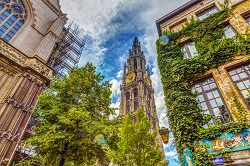Greening urban districts made easier with new software
Making our cities more sustainable is key to the fight against climate change and to a more environmentally-friendly future. Today, much of the work to reduce carbon emissions and integrate more nature in cities focuses on the small-scale. This includes retrofitting buildings with energy efficient windows or solar PV panels. However, much more progress could be achieved if changes could be coordinated at city-district level. For example, renewable district heating systems could be incorporated and open green spaces could be expanded. The EU-funded project ECODISTR-ICT is hoping to boost coordination by creating new software that allows a variety of stakeholders to get involved and plan a more environmentally-friendly urban community together. ‘We thought that if the different stakeholders concerned could work together, green measures could be implemented on a much broader level and economies of scale would kick-in, boosting the financial viability of projects,’ says Han Vandevyvere, ECODISTR-ICT Project Coordinator from VITO EnergyVille, Belgium. Throughout the project, the researchers developed new, open-source software called the ECODISTR-ICT Integrated Decision Support System (IDSS). The system is accessible via a password login for citizens and decision makers in the specific district concerned. The IDSS connects the main decision makers in an urban district and allows them to develop a coordinated approach to retrofitting buildings and renovating districts. It also gets local citizens involved via web-based questionnaire tools that collect relevant data such as energy consumption figures. Moreover, citizens’ opinions can be factored in by putting possible future district designs to vote. The software was designed to be a common data platform that takes local climate, local policies and local culture into account. To do this, decision makers can set their own Key Performance Indicators (KPIs) such as energy consumption, affordability or available green spaces and chose which calculation tools to add to the software. ‘The platform unites users in a single online environment to overcome current fragmentation, to design a vision for a district. It analyses the costs and benefits of various design options that plan for the entire life cycle of buildings,’ explains Vandevyvere. ‘Expert users’ such as architects and urban planners, can then use the tools included in the software such as a map-based editor to create new scenarios for the district. During the project, the IDSS was implemented in five different locations across Europe: the Kiel neighbourhood in Antwerp, Belgium; Rubroek in Rotterdam, the Netherlands; Campanar in Valencia, Spain; Służewiec Przemysłowy in Warsaw, Poland and Hovsjö, near Stockholm, Sweden. In each case, the project demonstrated how the ECODISTR-ICT IDSS can help plan urban district renewal. The case studies also confirmed the need for location-specific urban renewal objectives, as opposed to a one-size-fits-all planning approach. Project partners are now exploring the opportunities to use ECODISTR-ICT’s software in urban retrofitting projects across Europe and beyond. Meanwhile, several research projects are interested in using the IDSS as part of their urban planning toolset. A small team of project partners are planning to offer an ECODISTR-ICT web service as a commercial spin-off from the project. The team would take care of ICT-related tasks including setting up servers and offering helpdesk support so future IDSS users such as city administrators, architects and urban planners could focus on content.
Keywords
ECODISTR-ICT, sustainable cities, renewable energy, ecosystems, nature, urban renewal, planning



